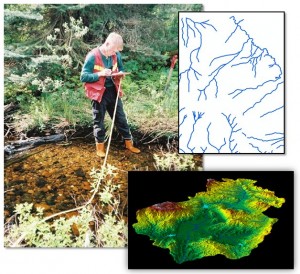Thinking Canadian: What is the Power of GIS?
What is the power of GIS?
What we have to do is separate GIS from software and hardware. GIS has been on this planet a lot longer than computers, servers, and software. The power lies in the people who analyze the data and the perspective/knowledge that they bring to the analysis.
Don’t get me wrong. I love modern-day GIS. I love my GIS lab filled with computers. I love statistical analysis. I love programming. I love cartography. But in my experience, it’s the ‘who’ and ‘why’ that make GIS so powerful.
- GIS is the person who has identified (and clearly understands) the problem before him/her. And knows what they want/need in the end.
- GIS is the person who understands EXACTLY WHY they are solving the problem in front of them.
- GIS is the person who understands that organization and metadata are not just nerd-words.
- GIS is the person who can look at the resultant of a problem and quickly answer the question “given my inputs and my throughputs … does my output make sense?”
- GIS is the person who understands (or is at the very least curious) that a pattern could exist because of variablex + variabley + variablez.
- GIS is the person who understands that reporting or displaying the analysis is just as critical as the analysis itself. If he/she can’t get people to “buy-in” to the cartographic output – then all the work that went into generating the output is useless.
- GIS is the person who understands the basic principles of what happens when things are added, subtracted, or intersected.
- GIS is the person who understands that sometimes something can be related to just one thing … and sometimes it can be related to more. And that more relationships means more connections between the information. (Anyone who has misbehaved as a child in a small town can attest to this.)
- GIS is the person who understands that two things that exist in the same space or proximity can be problematic. And sometimes things need rules if they are going to share a space.
- GIS is the person who recognizes that everything has its place and that sometimes having a duplicate of something doesn’t always make you rich.
Software can be learned. We’ve all done it. Hardware can be purchased. We’ve all done it. Hours and resources can be allocated to a problem. But what are we left with after the dust settles? When software and hardware are purchased? And required allocated hours and space are provided to the project? We’re left with tools and time to solve a problem. We have the what, where, and how. But without the ‘who’ there is absolutely no fuel for this engine to run. Only with the ‘who’ in place are we really ready to use the tools in front of us to provide solutions.
Directly tied to the ‘who’ is the ‘why’. All the software and hardware in the world won’t provide a solution to a problem that can’t be clearly defined. I have a shed full of tools: hammers, saws, levels, drills … but when push comes to shove I couldn’t build a house. Why? I’m not a carpenter and I don’t understand the basic principles of carpentry. How is it any different to ask someone who isn’t an ecologist to build a geospatial ecological model that relies on the basic understanding of ecology?
 Essentially, the analyst needs to understand the underlying principles of the problem, i.e., GIS requires a strong working knowledge of the phenomenon being studied. Some may find it a little elitist to watch a GIS analyst shrug his/her shoulders at the science behind the problem and hear them say “It’s just biology. Plants. Animals. Data is data.” Perhaps a little insulting to the biologist who spent four or more years in university (and then maybe a lifetime more) learning their discipline. Just like GIS, biology has theories, rules, and models too. What biologists need is a tool to help them explore their theories, rules, and models. That’s not to say that it’s any less insulting for a biologist to shrug their shoulders and say “it’s only a computer program”. Learning GIS and understanding the science behind what we do is no less trivial. The biologist who wants to use GIS as an analytical tool had better pack their lunch … because they have another lifetime of learning ahead of them. GIS may be a tool, but it is also a way of thinking and framing a problem into a solution. And it requires intensive training to learn how to use it right. Programming. Modeling. Web. Remote sensing. Cartography. Statistics. Project planning. Database design. More than simply a “computer program”.
Essentially, the analyst needs to understand the underlying principles of the problem, i.e., GIS requires a strong working knowledge of the phenomenon being studied. Some may find it a little elitist to watch a GIS analyst shrug his/her shoulders at the science behind the problem and hear them say “It’s just biology. Plants. Animals. Data is data.” Perhaps a little insulting to the biologist who spent four or more years in university (and then maybe a lifetime more) learning their discipline. Just like GIS, biology has theories, rules, and models too. What biologists need is a tool to help them explore their theories, rules, and models. That’s not to say that it’s any less insulting for a biologist to shrug their shoulders and say “it’s only a computer program”. Learning GIS and understanding the science behind what we do is no less trivial. The biologist who wants to use GIS as an analytical tool had better pack their lunch … because they have another lifetime of learning ahead of them. GIS may be a tool, but it is also a way of thinking and framing a problem into a solution. And it requires intensive training to learn how to use it right. Programming. Modeling. Web. Remote sensing. Cartography. Statistics. Project planning. Database design. More than simply a “computer program”.
People and the science that they bring to the problem that are the grease that GIS slides on. This is the true power of GIS.








GIS has indeed been here a lot longer than computers. Overlaying layers of data is not new. We used to call it tracing paper.
We used tracing paper as layers and used tables for listing attributes, and related those to map layers by giving each table a refrence to a map number. We did analysis too. So, yes GIS has been here a lot longer than computers.
GIS software is a tool. GIS data enables the power of GIS to the extent of what it represents, and in the way how it is collected or created. GIS professionals put all of these two in the right formats and right context. Then, the delivery of spatial analysis or visualization of the GIS data allows management to discover new interpretations of GIS data. When understood properly, GIS transforms itself into a management decision-making tool. That’s the power of GIS.
The first recorded GIS was from 1700’s using tracing paper and used for Ecological studies. Unfortunately the maths V hand shading missed sufficient scrutiny giving an erranoue result.
Hi,
Yes u are right.The Power of GIS has been increasing day by day as it’s the best tool to make the decisions at right time, at right place for Govt Sectors, Private Sectors and Individuals..The Scope of this GIS technology is
enormous, eternal…
With Regards,
Laxma
Manager
Geosoft